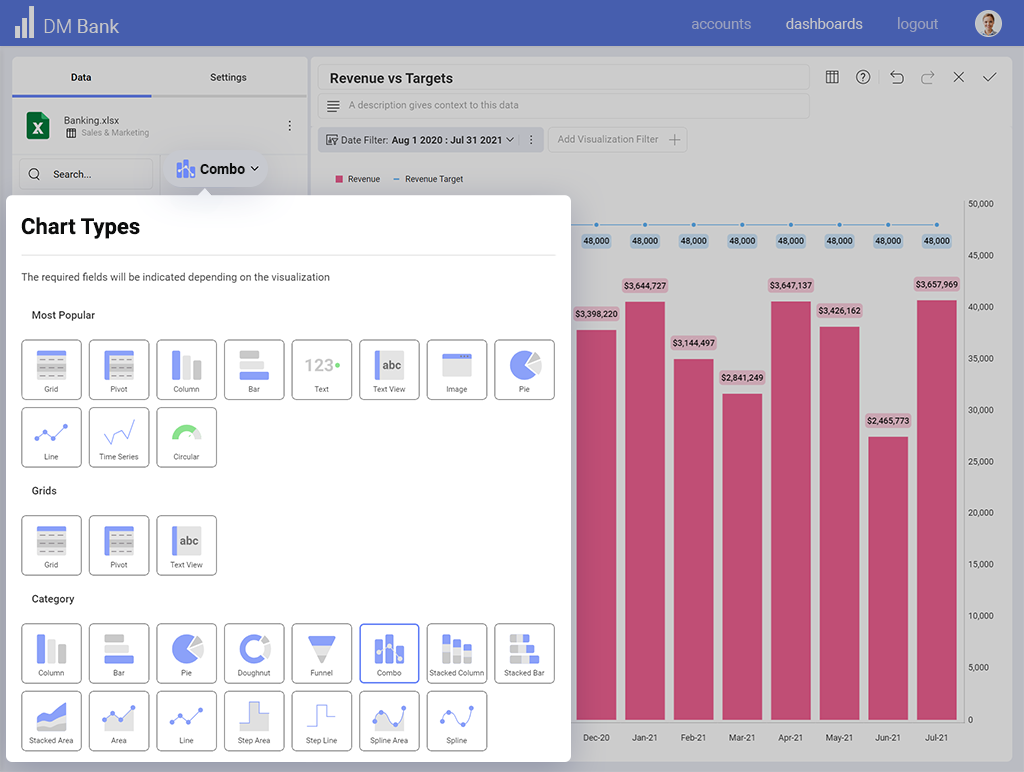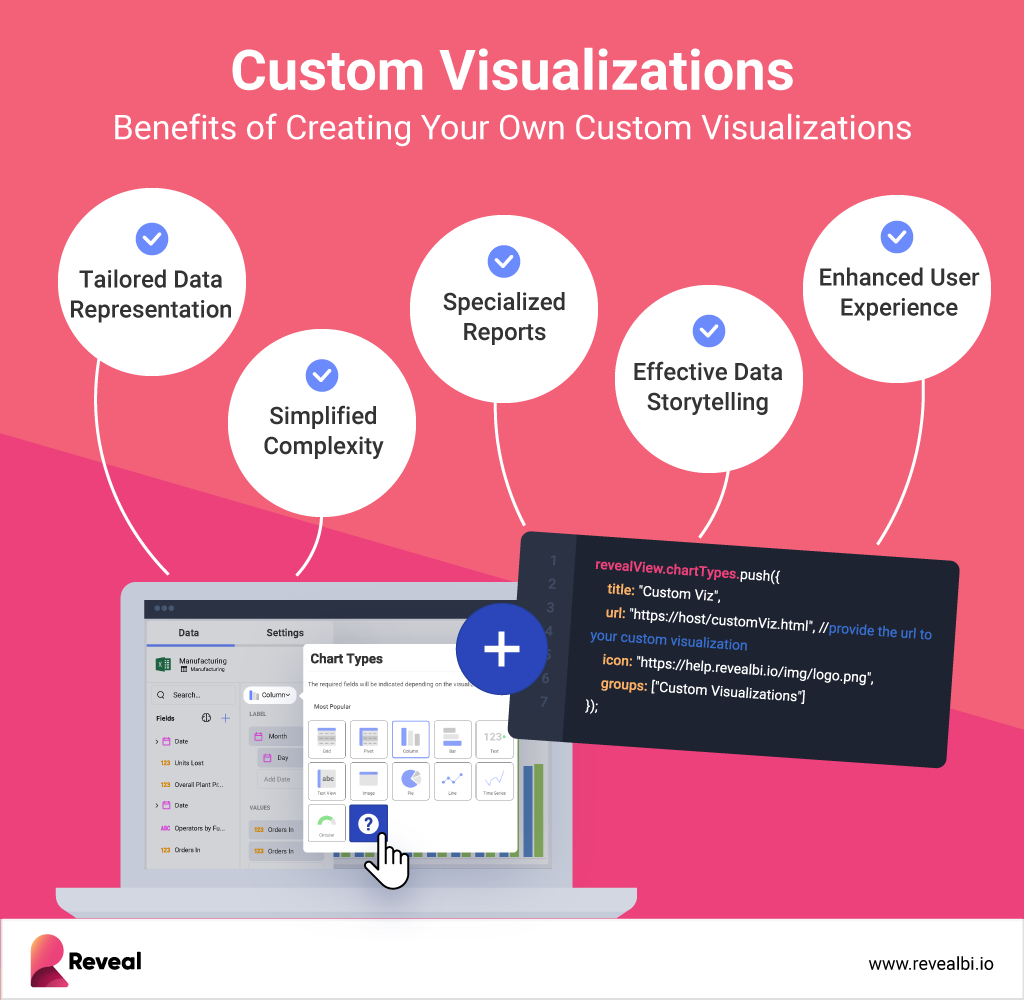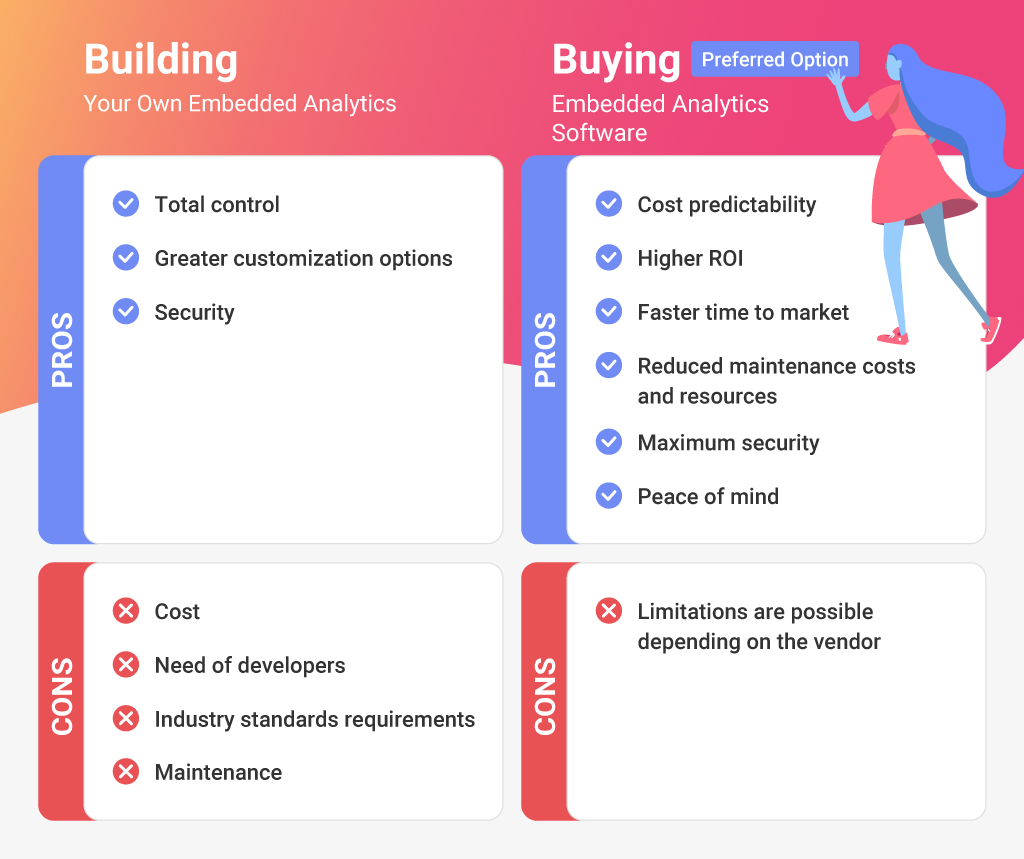
Scriptly ajuda as farmácias a identificar tendências em tempo real com Reveal
Ao iniciar um novo projeto, decidir qual Angular biblioteca de painéis usar é crucial para o sucesso do projeto. Uma biblioteca bem escolhida pode simplificar seu processo de desenvolvimento e aprimorar os recursos de análise do seu aplicativo.
Resumo:
Sabemos como é difícil criar dashboards, especialmente para aplicações web. Construir um do zero é ainda mais difícil. No entanto, executar operações de negócios ou campanhas direcionadas sem insights sobre sua eficácia não é uma opção. É para isso que servem os painéis. Eles rastreiam tudo, desde o comportamento do usuário até o desempenho do sistema. Na verdade, Angular painéis podem fornecer insights importantes que eventualmente permitirão a tomada de decisões baseada em dados em sua empresa.
Não é segredo que a tomada de decisão baseada em dados pode levar a melhores resultados para qualquer organização. Portanto, integrar painéis interativos em aplicativos da web é mais importante do que nunca. Se você é um gerente de produto ou um CTO, talvez já saiba o quão desafiador pode ser selecionar as ferramentas certas para construir esses painéis.
Angular é um framework popular para construir aplicativos web dinâmicos. Ele oferece várias opções quando se trata de bibliotecas de dashboard. No entanto, há muitas opções disponíveis. Como você sabe que está escolhendo a certa que se encaixa em suas necessidades? Não se preocupe. Estamos aqui para ajudar você a escolher a biblioteca de dashboard Angular ideal para seu próximo projeto.
Primeiro, vamos rever o básico: a biblioteca de painéis Angular é um conjunto de componentes e ferramentas pré-criados, projetados para simplificar a criação de painéis ricos em dados (e dinâmicos) em aplicativos Angular.
Essas bibliotecas geralmente incluem elementos como:
Eles também incluem outras ferramentas de visualização de dados que facilitam a exibição de dados complexos em um formato amigável e fácil de navegar. Então, em vez de construir um painel personalizado do zero, seus desenvolvedores podem usar essas bibliotecas e integrar recursos de painel em seus aplicativos de forma rápida e eficiente.

Não existe um tamanho único para todos quando se trata de construir um painel usando a biblioteca de painéis Angular. Você tem que escolher os componentes e ferramentas que atendem às suas necessidades. Para fazer isso, seus desenvolvedores e equipes de produtos terão que considerar vários fatores ao avaliar bibliotecas potenciais. Então, vamos dividir os critérios mais importantes que eles podem usar para ajudar você a tomar uma decisão baseada em dados.
A primeira coisa a saber é que integrar análises avançadas em um aplicativo Angular é uma tarefa assustadora. Muitas bibliotecas de dashboard exigem que os desenvolvedores gastem uma quantidade significativa de recursos para garantir que os recursos de análise sejam funcionais e de alto desempenho. Por exemplo, incorporar dados em tempo real ou relatórios avançados requer uma lógica de back-end extensa para dar suporte a isso.
Para gerentes de produto e CTOs, a complexidade de integrar análises em um painel pode escalar para uma situação de "gargalo" da mesma forma. Sem a biblioteca de painéis Angular certa, sua equipe pode estar desperdiçando meses construindo e ajustando uma solução, apenas para perceber que ela não pode ser dimensionada ou atender às suas necessidades de negócios de forma eficaz.
Portanto, uma biblioteca de dashboard Angular bem projetada deve oferecer opções de integração prontas para uso. Isso permitirá que sua equipe se concentre na experiência do usuário em vez de reconstruir recursos complexos do zero.
Não há dois aplicativos exatamente iguais. Para a maioria das equipes, um painel Angular padronizado não é suficiente. Portanto, a opção de personalizar a aparência do seu painel é importante, principalmente porque ele precisa se assemelhar aos padrões de design da sua marca (e às expectativas do usuário).
No entanto, muitas bibliotecas de dashboard Angular são especialmente desafiadoras nessa área. Você pode se ver preso a modelos rígidos ou layouts predefinidos que não permitem personalização nesse nível. Algumas bibliotecas exigem conhecimento significativo de estruturas de código interno. Enquanto isso, outras exigem integrações de terceiros até mesmo para as mudanças mais simples.
Nota: As melhores bibliotecas de dashboard devem permitir estilo e personalização fáceis também. Isso se aplica tanto ao layout quanto à funcionalidade dos componentes de dashboard escolhidos.
Deve ajudar você a:
Se você escolher uma boa biblioteca de painéis Angular, poderá fazer tudo isso e muito mais sem precisar de amplo conhecimento técnico.

Um dos fatores mais críticos ao escolher uma biblioteca de dashboard Angular é o desempenho. Isso ocorre porque os dashboards são pesados em dados devido aos seus grandes conjuntos de dados, ou seja, processados e exibidos em tempo real.
No entanto, os aplicativos precisam ser dimensionados e, como resultado, o volume de dados aumenta. Isso torna um pouco mais desafiador para os painéis fornecerem uma experiência de usuário suave e responsiva. Portanto, ao avaliar uma biblioteca de painéis, considere o quão bem ela se sai sob cargas pesadas de dados.
Será capaz de renderizar grandes conjuntos de dados sem atrasos ou atrasos significativos? Como a biblioteca lida com atualizações em tempo real ou visualizações de dados complexas?
Para empresas e OEMs, o desempenho é a principal prioridade. Ele dirá se seu painel de análise pode ser dimensionado efetivamente sem comprometer a experiência do usuário. Portanto, escolha uma biblioteca que priorize velocidade, capacidade de resposta e, mais importante, otimização de desempenho.
As demandas do usuário no painel aumentarão quando seu aplicativo crescer. Portanto, seus desenvolvedores precisam escolher uma biblioteca de painel Angular que possa lidar com esse crescimento por meio da escalabilidade em termos de capacidade de dados e interação do usuário.
Por exemplo, pense em como sua biblioteca lidará com milhares de usuários acessando o painel simultaneamente. Ou talvez, como ela processará grandes volumes de dados quando mais métricas começarem a entrar no sistema? A biblioteca será dimensionada horizontalmente em vários servidores? Ou exigirá ajustes significativos quando seu aplicativo crescer?
Essas perguntas ajudarão você a entender se suas equipes podem incorporar painéis analíticos nos aplicativos para uso a longo prazo.
Por outro lado, uma solução mal dimensionada resultará em gargalos, travamentos e usuários frustrados.
Tempo é dinheiro. Líderes empresariais entendem a necessidade de entrega e iteração rápidas. É por isso que escolher uma biblioteca que acelere o time-to-market é essencial. Como isso acontece por meio Angular?
Bem, a biblioteca de painéis certa lhe oferecerá:
Elas ajudarão sua equipe a ir do conceito à implantação rapidamente. Idealmente, a biblioteca que você escolher deve ter documentação e recursos de suporte da comunidade ativa também. É aqui que seus desenvolvedores podem encontrar soluções e discussões no fórum para lidar com gargalos de fluxo de trabalho de forma eficaz.
Um SDK robusto é uma ótima maneira de acelerar a integração. Por exemplo, Angular analytics dashboard SDK da Reveal oferece componentes prontos para uso e ferramentas de integração simplificadas. Por sua vez, ele permite que qualquer equipe reduza o tempo de desenvolvimento e mantenha um padrão de alta qualidade.
Você realmente deveria construir um dashboard do zero usando o dashboard Angular, ou há uma opção melhor? Integrar um dashboard Angular ao seu projeto pode ser extremamente simples porque você pode comprar uma biblioteca de dashboard Angular existente.
No entanto, essas duas estratégias vêm com conjuntos individuais de prós e contras. Esses prós e contras dependerão dos recursos, cronograma e necessidades específicas da sua equipe. Então, vamos dividir os principais fatores para ajudar você a decidir.
Você decide construir uma solução de painel personalizada que seja atraente e funcional. Com essa estratégia, você terá mais controle sobre o design e a funcionalidade. Portanto, você pode personalizar o painel para atender às necessidades do seu projeto.
No entanto, há alguns desafios a ter em mente também:
Para resumir, construir uma solução personalizada pode ser a solução certa para você. Mas isso só se você tiver uma necessidade única e bastante tempo e recursos. No entanto, essa abordagem ainda pode atrasar projetos e aumentar os custos para muitas equipes.

Por outro lado, se você comprar uma biblioteca de painel de Angular existente, há vários benefícios significativos.
Isso inclui:
Então, qual é o veredito? Para a maioria das equipes, comprar uma biblioteca de dashboard Angular existente é a solução mais eficiente e econômica. Você terá um dashboard escalável e de alta qualidade com a flexibilidade de personalizá-lo conforme necessário. Isso também significa que sua equipe não terá que fazer nenhum trabalho pesado que vem com a construção e manutenção de uma solução de dashboard do zero.
Quando se trata de incorporar análises em painéis Angular, Reveal é a melhor escolha. É uma solução de análise incorporada que oferece uma experiência perfeita e personalizável para profissionais.
Existem vários recursos importantes que ajudam Reveal BI a se destacar de seus concorrentes:
Escolher a biblioteca de dashboard Angular certa não é uma decisão fácil. Ela afeta significativamente o sucesso de seus aplicativos web. Portanto, você precisa considerar fatores como escalabilidade, personalização e otimização de desempenho para tomar uma decisão informada.
Se você está procurando uma solução de fácil integração e alto desempenho que também seja escalável, Reveal é a melhor solução do mercado. Com a biblioteca de painéis de análise Angular e soluções personalizadas do Reveal, você pode acelerar seu ciclo de desenvolvimento sem esforço. Como resultado, você poderá fornecer painéis dinâmicos e responsivos aos usuários para uma melhor tomada de decisão em toda a organização.
Voltar ao topo